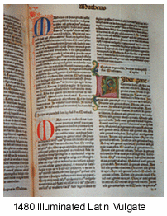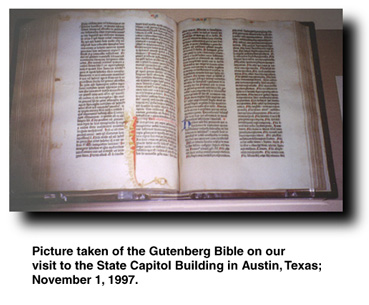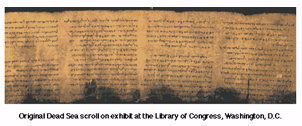
Throughout history, various types of Bibles and manuscripts have been transcribed that have changed the course of history within the Judeo-Christian religious communities of the world. Below I have provided a brief, yet informative, overview of these writings.
500 BC: Completion of all original Hebrew manuscripts which make up the 39 Books of the Old Testament.
In the second century B.C., at the request of Ptolemy II, the Hebrew Bible which basically consisted of what we know of as the 39 books of the Old Testament was translated into Greek, the common language of it's time. This translation is better known as the Septuagint, meaning 70, which is often abbreviated by the Roman numeral LXX. Seventy is supposedly the number of elders chosen from Israel that took on the task of this translation. The Septuagint was the primary translation used by Hellenistic Jews and thus was often used by Christians in the early church days.
1st Century AD: Completion of all original Greek manuscripts which make up The 27 books of the New Testament.

Then, in 382 A.D., Pope Damascus commissioned the work of the Bible to be translated into Latin, which at the time was the common language of it's day due in part to the influence of the Roman Empire. Jerome was the one chosen to take on the daunting task of translation. He relied heavily upon the original Hebrew and Aramaic text for his translation instead of using the Greek text of the Septuagint. The whole project of this translation took 20 years and was finally completed and published in 405 A.D. This became known as the Latin Vulgate.
500 AD: Scriptures have been translated into over 500 languages.
600 AD: Latin was the only language allowed for Scripture.
995 AD: Anglo-Saxon (early roots of English language) translations of the New Testament produced.

During the Middle Ages (600-1200 A.D.) the Masoretic Text was transcribed by a school of scholarly Jews known as the Masoretes. This text consisted of the already existing Hebrew Bible with vowel signs, accent marks, and marginal notes known as the Masorah added to it. Their work began somewhere around 600 A.D. and were still known to have existed around the 10th century. Today, the Masoretic Text serves as the basis for the Hebrew Bible and for most translations from Hebrew into other languages including the more popular English versions. Until the discovery of the Dead Sea Scrolls (1948) our oldest version of the Bible’s Hebrew text was the Aleppo Codex (A.D. 935) which was only 1,000 years old. As old as that may seem it was still over 1,000 years removed from the originals from which the Bible was duplicated and passed on.
1384 AD: Wycliffe is the first person to produce a (hand-written) manuscript copy of the complete Bible; all 80 books including the Apocrypha.
Recently, my wife and I had the fortunate privilege of visiting the state capitol of Texas (Austin) for our 1 year wedding anniversary. As we were touring the capitol building we were informed by the tour guide that there was a "Book Fair" presently taking place within the building. She had also stated that one of the notable features presented at the fair was that one of the original Gutenberg Bibles were on display in the main foyer. Suddenly, my interest in the capitol building had waned, and were now directed to this display of the Gutenberg Bible.
The Bible was encased within a glass box with quite an elaborate security system installed onto it. Standing nearby was a fully armed security officer guarding it closely.
 After all, the value of this Bible is well into the millions if not hundreds of millions of dollars! As the picture illustrates, it is quite beautiful. The large letters at the beginning of each chapter are illumined and adorned in fine gold. The cover was beautifully handcrafted with some form of a darkened wood, perhaps mahogany or even cherrywood. And amazingly, the Bible was remarkably well preserved considering it was well over 500 years old!
After all, the value of this Bible is well into the millions if not hundreds of millions of dollars! As the picture illustrates, it is quite beautiful. The large letters at the beginning of each chapter are illumined and adorned in fine gold. The cover was beautifully handcrafted with some form of a darkened wood, perhaps mahogany or even cherrywood. And amazingly, the Bible was remarkably well preserved considering it was well over 500 years old!
I didn't know much about the Gutenberg Bible except that it was the first printed Bible of the "movable type" by the famous Jonannes Gutenberg. Below is a brief overview of the Gutenberg Bible:
*Gutenberg, Johannes Gensfleisch zum (ca. 1396-ca. 1468). He was a German printer and inventor of movable type. Around 1430 he began to experiment with printing. In about 1449, he apparently had movable metal type formed in separate letters, and had invented a typecasting machine along with an oil-based ink printer. He later became partners with Johannes Fust, a banker, so that he could have funding for a large Latin Bible in two-column format, with each page containing 42 lines. The types he prepared comprised not only the 24 capital and 24 lowercase letters of the Latin alphabet, but 290 different characters (47 capitals and 243 lowercase letters). Gutenberg cast such a great number of types because he wanted to reproduce as accurately as possible the detail of letters in sumptuous medieval manuscripts––and, if he could, to surpass their beauty through his new art. According to most critics, Gutenberg's Bible is better proportioned and harmonized than any other manuscript, including those transcribed with the greatest care. Because he printed with an exceptional deep black ink, the Bibles retain their fresh lustre to this day.
Generally bound in two massive folio volumes, the Gutenberg Bible comprises 1,282 double-columned pages. The pages measure 15 1/2" x 11 1/8". It is believed that 150 copies were printed on paper and about 35 on parchment (vellum). Almost 6,000 calves were needed to supply enough vellum for the 35 parchment copies of this Bible. Printing of the Bible began in approximately 1452, however, due to complications, the completion of printing wasn't until late 1455 or early 1456. Only 12 parchment and 36 paper copies of the original Gutenberg Bible are known to exist worldwide; four of the parchment copies are complete, as are seventeen of the paper copies.
1516 AD: Erasmus produces a Greek/Latin Parallel New Testament.
1522 AD: Martin Luther's German New Testament.
 William Tyndale, "the Father of the English Bible," was born in Glouchester, England in 1494. He attended both Oxford and Cambridge University's obtaining both his undergraduate and graduate degrees. In 1526, professor Tyndale, under much scrutiny, was the first to translate the New Testament into English. His translation was the first printed New Testament in English and the first to be translated directly from the original Greek version. About 18,000 of the original versions were printed with only two of these having survived. He later went on to translate the Old Testament directly from it’s original Hebrew in 1530. Because of these translations, he was accused of heresy and was once labeled the "son of Antichrist" by Sir Thomas More, the Lord High Chancellor. He was later arrested and executed, he died a martyr at the stake on October 6, 1536. His last words upon dying were, “Lord, open the King of England’s eyes!”
William Tyndale, "the Father of the English Bible," was born in Glouchester, England in 1494. He attended both Oxford and Cambridge University's obtaining both his undergraduate and graduate degrees. In 1526, professor Tyndale, under much scrutiny, was the first to translate the New Testament into English. His translation was the first printed New Testament in English and the first to be translated directly from the original Greek version. About 18,000 of the original versions were printed with only two of these having survived. He later went on to translate the Old Testament directly from it’s original Hebrew in 1530. Because of these translations, he was accused of heresy and was once labeled the "son of Antichrist" by Sir Thomas More, the Lord High Chancellor. He was later arrested and executed, he died a martyr at the stake on October 6, 1536. His last words upon dying were, “Lord, open the King of England’s eyes!”
1535 AD: Myles Coverdale's Bible; the first complete Bible to be printed in the English Language (80 Books: O.T. & N.T. & Apocrypha).
1537 AD: Matthews Bible; the second complete Bible to be printed in English. Done by John "Thomas Matthew" Rogers (80 Books).
1539 AD: The "Great Bible" printed; the first English language Bible to be authorized for public use (80 Books).
1560 AD: The Geneva Bible printed; the first English language Bible to add numbered verses to each chapter (80 Books).
1568 AD: The Bishops Bible printed; the Bible of which the King James was a Revision (80 Books).
1609 AD: The Douay Old Testament is added to the Rheimes New Testament (of 1582) making the first complete English Catholic Bible; translated from the Latin Vulgate (80 Books).
The King James Version began when a group of English Puritans ambushed King James I of Scotland while he was on a journey and presented him with a petition requesting a new translation of the Bible. Since the petition contained a thousand signatures, it was called the "Millenary Petition". The Puritans yearned for a new translation of the Bible, because most of the existing English Bibles were biased and polemic. Beforehand, only the Latin versions were primarily used, in which only ecclesiastical authorities were authorized and knew how to read it. The common folk were at their mercy in understanding the content of the Bible. In 1603, to their surprise, the king readily agreed and assembled the most knowledgeable and best Bible scholars from England to undertake the project. They were dismayed at first when the king announced he would personally manage the project, but they were pleasantly surprised when it turned out that he had an excellent background in the subject. By 1611, it was published and became the "authorized" version of the common people. The resulting translation was made mandatory for the Church of England, over many protests from the clergy. Because books were extremely expensive in those days, well out of the reach of the common person, the law also required every church to keep a copy on display 24 hours a day, so that ordinary people could come in and read the Bible at their leisure. The Bibles were generally chained to the reading desks to prevent them from being stolen. The cost of replacing a stolen Bible in those days could easily bankrupt a local parish.
polemic. Beforehand, only the Latin versions were primarily used, in which only ecclesiastical authorities were authorized and knew how to read it. The common folk were at their mercy in understanding the content of the Bible. In 1603, to their surprise, the king readily agreed and assembled the most knowledgeable and best Bible scholars from England to undertake the project. They were dismayed at first when the king announced he would personally manage the project, but they were pleasantly surprised when it turned out that he had an excellent background in the subject. By 1611, it was published and became the "authorized" version of the common people. The resulting translation was made mandatory for the Church of England, over many protests from the clergy. Because books were extremely expensive in those days, well out of the reach of the common person, the law also required every church to keep a copy on display 24 hours a day, so that ordinary people could come in and read the Bible at their leisure. The Bibles were generally chained to the reading desks to prevent them from being stolen. The cost of replacing a stolen Bible in those days could easily bankrupt a local parish.
1782 AD: Robert Aitken's Bible; the first English language Bible (a King James Version without Apocrypha) to be printed in America.
1791 AD: Isaac Collins and Isaiah Thomas respectively produce the first Family Bible and first Illustrated Bible printed in America. Both were King James Versions, with all 80 books.
1808 AD: Jane Aitken's Bible (daughter of Robert Aitken); the first Bible to be printed by a woman.
1833 AD: Noah Webster's Bible; after producing his famous dictionary, Webster printed his own revision of the King James Bible.
1841 AD: English Hexapla New Testament; an early textual comparison showing the Greek and 6 famous English translations in parallel columns.
1846 AD: The Illuminated Bible; the most lavishly illustrated Bible printed in America. A King James Version, with all 80 books.
1885 AD: The "Revised Version" Bible; the first major English revision of the King James Bible.
1901 AD: The "American Standard Version"; the first major American revision of the King James Bible.
Lastly, in 1947, young Bedouin shepherds, searching for a stray goat in the Judean Desert entered an old, long-uninhabited cave and stumbled upon some jars containing ancient scrolls. This discovery immediately brought scientists of all fields, archaeologists, and the media from all around the world into a scurrying frenzy to this ancient region of the Middle East known as Qumran.
 Within a decade, more of these ancient scrolls were found within the region, and shortly thereafter, after a multitude of tests (historical, paleographic, carbon-14 dating, etc.) it was conclusive that the scrolls and the caves themselves dated from the 3rd century B.C. to 68 B.C. That would make these scrolls older than any other surviving biblical manuscripts by almost a thousand years!
Within a decade, more of these ancient scrolls were found within the region, and shortly thereafter, after a multitude of tests (historical, paleographic, carbon-14 dating, etc.) it was conclusive that the scrolls and the caves themselves dated from the 3rd century B.C. to 68 B.C. That would make these scrolls older than any other surviving biblical manuscripts by almost a thousand years!
Scholars believe these ancient scrolls are the compiled writings of the Essene Jews while others believe it is the writings of several sects of the Judaic religion. The scrolls themselves contain the entire text of the Hebrew Bible (with the exception of the Book of Esther), and includes some apochryphal or pseudepigraphical works, and some sectarian writings, (i.e. commentaries, ordinances, references, etc.). All of which were written in three different languages: Hebrew, Aramaic, and Greek.
The scroll of Isaiah, in the initial finds from the site of Qumran, has remained the best known of the discoveries. It was the first major biblical manuscript of great antiquity to be recovered. It is earlier by a millenium than the oldest Hebrew text preserved in the Masoretic Hebrew Bible.
What is the significance of this amazing discovery? It remarkably shows the preservation, accuracy, and historocity of both the text and context of the Bible. In this case, the Old Testament. Very little, if any changes had occurred between the time of these writings (68-300 B.C.) to the present time. The only deviation that has occurred from that time are only minor textual changes and do not effect the context or it's original meaning.
The Bible itself has withstood the test of time and man, only by the grace and will of God!
1971 AD: The "New American Standard Bible" (NASB) is published as a "modern and accurate word for word English translation" of the Bible.
1973 AD: The "New International Version" (NIV) is published as a "modern and accurate phrase for phrase English translation" of the Bible.
1982 AD: The "New King James Version" (NKJV) is published as a "modern English version maintaining the original style of the King James."
* - Ref: The Oxford Companion to the Bible, 1993, pgs. 263-264, Bruce M. Metzger, Oxford University Press
![]()